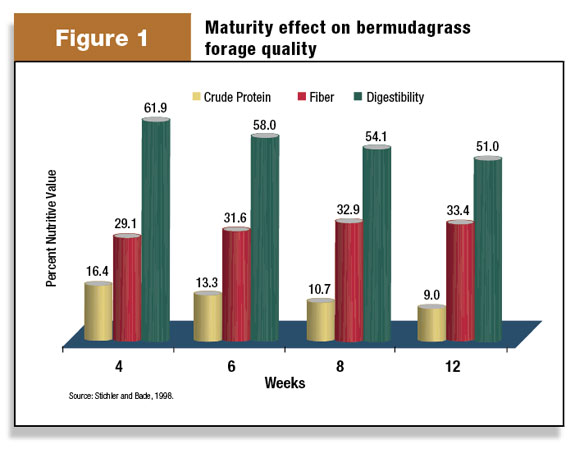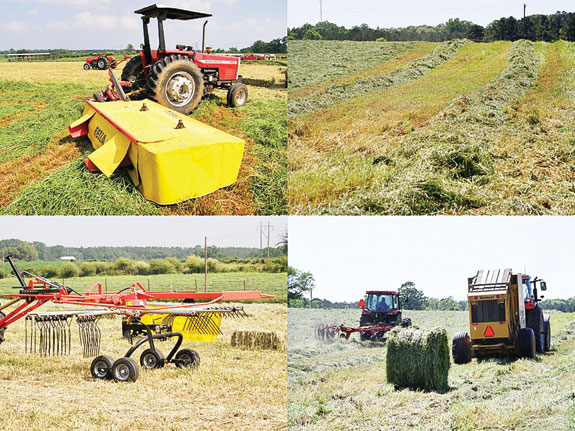Excellent-quality hay has a high nutritive value and animal intake. Hay quality can differ widely within a single species grown in the same location due to management. The nutritive value of the final product depends on many factors in the hay production system, such as maturity, curing and storage.
Following good haymaking practices ensures higher hay quality, which lowers the amount of nutrients needed for supplementation and therefore translates into lower feed costs.
Of all the factors affecting hay quality, the stage of maturity is the most important and the one in which the greatest progress can be made.

As plants mature from a vegetative (lush growth) to a reproductive stage (seed head), they become higher in fiber and lignin content. This lowers the protein content, digestibility and forage intake by the livestock ( Figure 1 ).
Forages should be cut at the right stage. For example, bermudagrass should be cut when height is 15 to 18 inches (four-week to five-week intervals), small grains (oats and wheat) at the boot stage (stage before seed emergence), summer annuals (sudangrass, sorghum hybrids, pearl millet) at 40 inches and tall fescue at four-week to six-week intervals.
Making cuts at the correct growth stage promotes growth when temperature and soil moisture might be favorable for plant growth and could increase total yield per acre if optimum soil nutrients are available.
Hay made from the best adapted species and fertilized properly can still result in suboptimal forage if not properly handled and cured. The curing process involves different stages such as mowing, tedding, raking and baling.
One common question asked is: At what time of the day should I cut my hay? Hay should be cut when sugar and starch or total nonstructural carbohydrates (TNC) are highest in the plant.
Plants have lower TNC in the morning because plants use carbohydrates for respiration during the night. TNC concentration increases throughout the day and usually reaches peak by 6 p.m.
It is recommended to cut hay in early to mid-afternoon because cutting hay too late in the day will not allow the hay to dry substantially, losing TNC to respiration at night.
TNC losses can also be affected by forage moisture and air temperature. When mowing hay, set the mower to make the swath as wide as possible. This exposes more of the forage to the drying effects of the sun and wind.
Conditioning (crushing the stems) at the time of mowing will improve curing by allowing the stems to dry at nearly the same rate as the leaves.

Conditioning has been shown to decrease the drying time of large-stemmed plants by almost one day, resulting in less leaf and nutrient loss.
Hay tedding is only valuable for turning the swath and allowing the forage that was on the bottom or in clumps to come to the top and dry better, resulting in a more uniform drying pattern.
Tedding should usually be done the morning after the hay has been cut and after the dew is off.
Producers should be cautious on tedding hay that is too dry or tedding too often, because this can create leaf shattering and cause losses in forage quality and yield.
Raking will allow for increased drying before the hay is baled. It is important to rake in a way that will minimize leaf loss. Raking when the hay is slightly brittle and not covered with dew will reduce leaf loss. It is important to set the rake at an optimum speed that will minimize forage losses.
Baling is the final step in hay curing. Optimum moisture for baling can range from 15 to 20 percent depending on the type of forage species and the type and size of bale being made.
Baling at moisture levels lower than 15 percent will result in greater harvesting losses because leaf loss increases as moisture content decreases.
On the other hand, storing hay at moisture levels greater than 20 percent can result in molding and heating, which translate into hay discoloration and greater dry matter and nutrient losses.
Although there are electronic moisture meters that could be used in the windrow, they are more accurate in determining moisture content when the hay is baled.
An experienced hay producer might be able to take a handful of hay from the underside of the windrow and twist it to determine if the hay is dry enough. If the stems are brittle and free of moisture, the hay should be in good condition for baling.
All bales made at moisture content above 15 percent will undergo some increase in temperature in the first two to three weeks post-baling.
This change in temperature is known as “sweating” or “going through sweat,” and this is due to the final stage of plant and microbial respiration.
This increase in temperature can cause spontaneous combustion if bales are stored too tight or in close environments.
When storing hay in a barn or outdoors, do not stack more than five tiers high before the hay has gone through the sweating process.
After the sweat, when temperatures lower, more tiers can be added to the stack without fire danger. Fire danger usually increases when bales reach temperatures above 150ºF. Heating bales must be moved to prevent the stack or barn from burning.
Check the bale moisture content by using a hay moisture probe to determine the potential for greater respiration.
To measure the bale temperature, use a thermometer that can be pushed at least 12 inches into the bales and check the temperature from at least 20 different bales and monitor the hay stack daily until the sweat period is over. It is recommended to wait at least three weeks before storing hay in a barn.
Hay can be a low-cost, high-quality conserved feed. A better understanding of hay losses and quality changes associated with hay storage conditions is critical to reduce feeding costs.
Total loss for high-quality hay stored outside on the ground could range from 25 to 45 percent. This dry matter loss from poorly stored hay also translates to dollar values related to the amount of nutrients that have to be supplemented as protein or energy products.
Placing round bales in pallets, tires, gravel or using a tarp minimize dry matter losses. Some studies have shown these techniques reduce storage losses by 15 percent.
Hay production can be a complicated process. Yet producing high-quality hay should be a goal of each hay producer. Cutting hay at proper stage of maturity and moisture content and providing proper fertilization will allow livestock producers to get higher-quality hay and reduce possible supplementation.
Don’t guess, hay test! Know what you are feeding and supplement with protein or energy when necessary.
A successful hay production and utilization depends on the integration of harvest management, hay preservation and quality analysis.
Always remember that haymaking is an art, and understanding the science behind it can help hay producers to make a cost-effective and nutritional livestock feed. PD
References omitted due to space but are available upon request. to editor@progressivedairy.com
—Excerpts from Mississippi State University Forage News, Vol. 4, No. 5
PHOTO: Of all the factors affecting hay quality, the stage of maturity is the most important and the one in which the greatest progress can be made. Photos courtesy of Rocky Lemus.

-
Rocky Lemus
- Extension Forage Specialist
- Email Rocky Lemus






